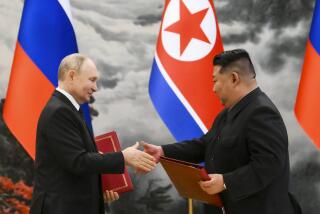North Korea could stumble from bluster to war
Beneath a map depicting the battle plan for “Target Mainland U.S.,” North Korean leader Kim Jong Un is shown in state propaganda photos being briefed by his generals on preparations for attacks on Guam, Hawaii and the U.S. West Coast.
Other scenes show the plump, baby-faced leader touring gun emplacements, watching landing maneuvers on the snow-dusted coast and peering southward through binoculars from a promontory near the DMZ.
Although bombast is a seasonal ritual in North Korea -- unleashed each spring, when the United States and South Korea carry out military exercises -- this year’s belligerence has escalated to alarming levels that have diplomats and security analysts worrying the verbal barrage could be more than bluster.
In the past month, Pyongyang has announced that it is abandoning the armistice it has observed with South Korea since 1953, cut off emergency communications with Seoul, put its rocket forces on high alert and threatened a preemptive strike against the United States for unspecified “provocations.” The regime has proclaimed itself in “a state of war” with South Korea, and on Tuesday announced it will restart an idled plutonium reactor to step up its nuclear energy and weapons programs.
The North Koreans’ amped-up hostility follows tightened U.N. sanctions imposed after it carried out a nuclear bomb test Feb. 12. Their vows to incinerate U.S. cities with nuclear strikes are dismissed as saber-rattling for domestic consumption, but Korea watchers are nonetheless concerned that Pyongyang has been emboldened by its one successful long-range rocket launch in December.
The North’s cascade of threats has spurred retaliatory warnings and elevated readiness in Seoul and Washington. The Pentagon dispatched two F-22 stealth fighters from Japan to South Korea over the weekend, and B-52 and B-2 bombers flew training runs last month in a show of force as part of war games near the Korean peninsula that run through the end of April. South Korea’s newly inaugurated president, Park Geun-hye, on Monday gave her military brass authorization to retaliate decisively in the event of an attack by the North.
A declaration by the ruling Workers’ Party on Sunday that North Korea will never give up its nuclear weapons represented a watershed change from founding father Kim Il Sung’s purported deathbed appeal for a nuclear-free Korean peninsula, said Victor Cha, a former National Security Council advisor on Korea now at the Center for Strategic and International Studies.
“He’s saying that his nuclear weapons are not up for negotiation,” said Cha, noting that many delegates to the on-again, off-again six-party talks with North Korea suspected as much but now have confirmation.
Kim’s digression from the more consistent threats issued by his grandfather and father has raised concern about his ability to contain a crisis of his own making. A novice in leadership and untested in battle, Kim is believed to have recently turned 30 but may be even younger, by some accounts.
“Part of the reason this is all so unsettling for everyone is that we really don’t know this new leadership,” Cha said of Kim, in power since the death of his father, Kim Jong Il, 16 months ago. “One day he’s threatening to blow up Austin, Texas, another he’s sitting there with [former basketball star] Dennis Rodman saying he just wants Obama to call him. North Korea has always been a little weird, but these are extremes of behavior we haven’t seen before.”
Stephan Haggard, a professor of Korea-Pacific studies at UC San Diego, sees the war of words as “ritualized escalation” and doubts either side is likely to take the first step that would set off a dangerous sequence of retaliation. But he too acknowledges that when forces are on high alert and threats of preemptive strikes are flying, however implausible, they “potentially create hair-trigger situations where even small tactical movements could be misinterpreted.”
Haggard predicted that Kim will persist with the menacing demonstrations, then declare success at deterring a U.S.-South Korean attack after his enemies’ military exercises are over.
Still, Charles K. Armstrong, director of Columbia University’s Center for Korean Research, worries that the heightened rhetoric reflects a changed focus in Pyongyang on the United States as Enemy No. 1 instead of longtime adversary South Korea.
“I don’t see any conceivable scenario in which North Korea would attack the U.S. mainland, even if it had the technological capability to do so, which they don’t. But it is getting to be very disturbing how they are talking about the United States” and broadcasting images of U.S. cities in flames, Armstrong said.
South Korea has also talked of a preemptive strike, he noted, and Park could be under pressure from hawks who feel her predecessor failed to wage appropriate retaliation three years ago when Pyongyang is believed to have torpedoed a South Korean warship engaged in military maneuvers, killing 46 sailors.
“If South Korea feels the North Korean threat is genuinely growing, it may decide even before a strike from the North to attack a North Korean facility,” Armstrong said.
And with the United States obliged by treaty to defend its South Korean ally, even threats meant as bluster, he noted, could result in “a very real and dangerous conflict.”
ALSO:
Jobless rate hits new record in Eurozone
Death of Palestinian prisoner in Israel sparks violence
North Korea analyst: ‘One of the most dangerous moments’
A foreign correspondent for 25 years, Carol J. Williams traveled to and reported from more than 80 countries in Europe, Asia, the Middle East and Latin America.
More to Read
Sign up for Essential California
The most important California stories and recommendations in your inbox every morning.
You may occasionally receive promotional content from the Los Angeles Times.











